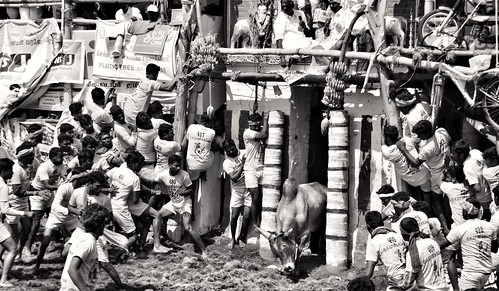Have been really handful of species in our study system that changed their
Were really few species in our study method that changed their winning proportions in any significant manner via 2 Myr of their evolution, suggesting stability in competitive abilities around the timescales of numerous thousand generations. Despite heterogeneity in our method stemming from several variables, including time, a altering climate, substrate availability and neighborhood composition, we had been able to quantify temporal dynamics in winproportions and identify encrusting bryozoan species which might be clear winners and other folks which might be clear losers. We chose a study palaeontological method in which we were able to identify most of the colonies to species level. In lots of palaeontological studies, including these asking questions about taxon richness and spatial distribution, the genus is often employed as a proxy for the species. In some cases, this can be justified [49,50], but in others it truly is less clear on each empirical and conceptual grounds [5]. This study would be the initial to examine whether the competitive abilities of species within a given genus reflect average genuslevel temporal dynamics PubMed ID:https://www.ncbi.nlm.nih.gov/pubmed/24295156 on geological timescales. Offered that there were only two genera in  which we could observe species dynamics over various time intervals, we cautiously and tentatively conclude that species idiosyncratically contribute to genus patterns on the subject of competitive skills, rendering the genus proxy an inappropriate a single for person speciesspecific concerns on competitiveness. There is certainly rather powerful clustering of interaction outcomes involving interspecific and intraspecific interactions. You will find a lot more intraspecific standoff interactions than expected in the species and time intervals for which data had been adequate to produce such a comparison. This observation provides us self-assurance that our samples capture a majority of reside ive (synvivo) interactions (see [0]), mainly because standoff interactions can not occur when 1 celebration is dead. You will discover also fewer interspecific standoff interactions than anticipated by opportunity, indicating some predictability in interaction outcomes, even though our information are at the moment not wealthy sufficient to statistically examine specific species pecies interactions in detail. For species that deviate from a null expectation for win ose and standoff interactions, most also interact more than anticipated. This may MedChemExpress Ribocil possibly imply temporal segregation, ecological clustering and mechanisms for attracting or repelling realized interactions. Ecological abundance doesn’t appear to be associated to competitiveness in any straightforward way in our system, corroborating findings in some living assemblages of bryozoans. For instance, Centurion Gappa [40] reported a adverse correlation in between competitive ability (defined as winlose ratios) and also the quantity of observed colonies. This damaging partnership resonates with theoretical observations that poor competitors is usually a lot more abundant [46] and vice versa. In our technique, as an example, Escharoides excavata can be a excellent competitor and incredibly widespread within the earliest formation in our dataset, but it `disappeared’ in the Wanganui Basin for practically two Myr prior to `reappearing’ in our modern samples from Cook Strait. Crepidacantha crinispina can be a constant loser, yet it truly is commonlyrspb.royalsocietypublishing.org Proc. R. Soc. B 283:present throughout the 2 Myr. As already talked about, we usually do not purport to possess reliably estimated unbiased relative abundance but emphasize that appropriate statistical estimation has to be created to infer eco.
which we could observe species dynamics over various time intervals, we cautiously and tentatively conclude that species idiosyncratically contribute to genus patterns on the subject of competitive skills, rendering the genus proxy an inappropriate a single for person speciesspecific concerns on competitiveness. There is certainly rather powerful clustering of interaction outcomes involving interspecific and intraspecific interactions. You will find a lot more intraspecific standoff interactions than expected in the species and time intervals for which data had been adequate to produce such a comparison. This observation provides us self-assurance that our samples capture a majority of reside ive (synvivo) interactions (see [0]), mainly because standoff interactions can not occur when 1 celebration is dead. You will discover also fewer interspecific standoff interactions than anticipated by opportunity, indicating some predictability in interaction outcomes, even though our information are at the moment not wealthy sufficient to statistically examine specific species pecies interactions in detail. For species that deviate from a null expectation for win ose and standoff interactions, most also interact more than anticipated. This may MedChemExpress Ribocil possibly imply temporal segregation, ecological clustering and mechanisms for attracting or repelling realized interactions. Ecological abundance doesn’t appear to be associated to competitiveness in any straightforward way in our system, corroborating findings in some living assemblages of bryozoans. For instance, Centurion Gappa [40] reported a adverse correlation in between competitive ability (defined as winlose ratios) and also the quantity of observed colonies. This damaging partnership resonates with theoretical observations that poor competitors is usually a lot more abundant [46] and vice versa. In our technique, as an example, Escharoides excavata can be a excellent competitor and incredibly widespread within the earliest formation in our dataset, but it `disappeared’ in the Wanganui Basin for practically two Myr prior to `reappearing’ in our modern samples from Cook Strait. Crepidacantha crinispina can be a constant loser, yet it truly is commonlyrspb.royalsocietypublishing.org Proc. R. Soc. B 283:present throughout the 2 Myr. As already talked about, we usually do not purport to possess reliably estimated unbiased relative abundance but emphasize that appropriate statistical estimation has to be created to infer eco.